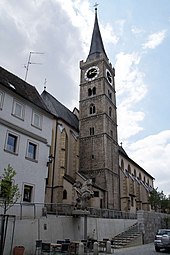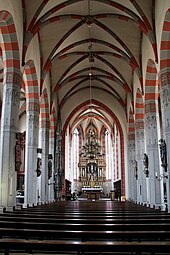St. Andreas (Ochsenfurt)
The Roman Catholic parish church of St. Andreas is a late Gothic hall church in Ochsenfurt in the Lower Franconian district of Würzburg in Bavaria . Like the neighboring Michaelskapelle, it belongs to the Ochsenfurt parish in the Ochsenfurt deanery of the Würzburg diocese and is located on the Franconian-Swabian Way of St. James from Würzburg to Ulm.
History and architecture
The oldest part of the church is the tower in the northeast corner, which comes from a building consecrated in 1288. It shows a slim six-storey structure partly in Romanesque , partly in early Gothic forms, the church building itself comes from the second half of the 14th century. The tower is finished with a crenellated wreath and a pointed helmet from the 17th century. The church consists of an elongated choir with a five -eighth end and a seven-bay hall longhouse with a clearly elevated central nave, i.e. a stepped hall . The vault is supported by octagonal pillars that merge with the separating arches with an unchanged profile . The low buttresses have led to the assumption that a basilica was once planned and the side aisles were only later changed. In 1736 a Johann Nepomuk chapel was added to the southeast corner , which includes the former sacristy ; today the sacristy is on the tower ground floor. The interior is accessed by a total of four portals, which are arranged on the north and south sides in the second and sixth yoke. The eastern portal on the north side has a tympanum decorated with tracery . The ribbed vaults rest on consoles. The windows are provided with rich geometrical tracery, which has developed to the point of isolated approaches of fish bubble tracery . A west gallery in stone runs through the three naves. The last repair took place in the years 1986–1991.
Furnishing
The high altar is the work of Georg Brenck the Elder from the years 1610–1612 and was rebuilt in 1953 after being replaced in 1892 by a neo-Gothic structure. It was supplemented with four lateral apostle figures and three crowning figures of saints, which were created by the Würzburg sculptor Adolf Friedrich during the restoration. The mighty, three-storey structure is richly decorated with reliefs and figures showing the Passion of Christ and the coronation of Mary . The tabernacle was also recreated in 1953, as the original from 1764 has not been preserved.
The graceful sacrament house to the left of the choir arch is of Nuremberg origin and was created between 1496 and 1498. A sacrament niche from the time the choir was built has also been preserved. The bronze baptismal font with a rich but somewhat stiff structure is a new version of the type created by Hermann Vischer the Elder in 1457 for the Wittenberg town church .
The choir stalls date from the end of the 15th century, but the parapet walls and the upper end have been renewed.
The stone group of the Magi on the second to fourth pillars of the north side was probably created at the beginning of the 15th century. An older Mother of God from the end of the 14th century at the latest stands on the first pillar of the nave on the north side. A clay statue of St. Andrew in the middle part of the gallery dates from around 1420.
A wooden figure of the painful Mother of God on the third pillar on the south side with a fine design of movement and drapery with free proportions was created around 1480. A stone figure of Christ as the Man of Sorrows from around 1345 is placed on the fourth pillar on the south side.
A very finely crafted wooden figure of St. Nicholas in the south aisle is probably a personal work by Tilman Riemenschneider from around 1510. A colored Madonna with the baby Jesus in the south aisle was created around 1500. The cycle of figures on the nave pillars and in the side aisles was completed with more recent figures by Adolf Friedrich.
On the back wall of the gallery are large oil paintings with depictions of the martyrdoms of Saints Sebastian and Barbara from 1677 by Oswald Onghers . On the outside of the choir there is a life-size group of mountains of olives made of stone from the 16th century. The organ is a work of the Winterhalter Orgelbau company from 1997 with 39 registers on three manuals and a pedal in a case by Johann Philipp Seuffert from 1754.
There are five bells, some of them historical, in the tower, four of which form the main bell. The largest of them is the citizen bell, which weighs around 2700 kilograms. It was cast in heavy rib by the then Würzburg master foundryman Hans Neuber in 1518 and is the largest of all his works that still exists. A total of only 27 new bell bells survived World War II. The chime sequence of the chimes is: c ′, es ′, g ′ and as ′.
literature
- Georg Dehio: Handbook of the German art monuments. Bavaria I. The administrative districts of Upper Franconia, Middle Franconia and Lower Franconia. Deutscher Kunstverlag, Munich / Berlin 1999, ISBN 3-422-03051-4 , pp. 825–826.
Web links
Individual evidence
- ↑ a b c Information on St. Andreas in Ochsenfurt on wuerzburgwiki.de. Retrieved November 22, 2019 .
- ↑ Information about the organ on orgbase.nl. Retrieved November 22, 2019 .
Coordinates: 49 ° 39 '51.3 " N , 10 ° 3' 48.1" E



